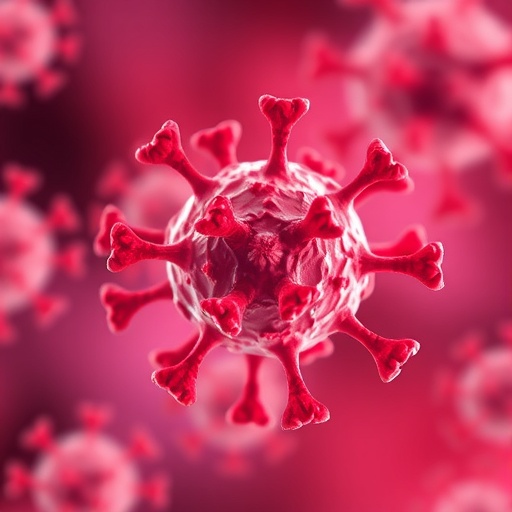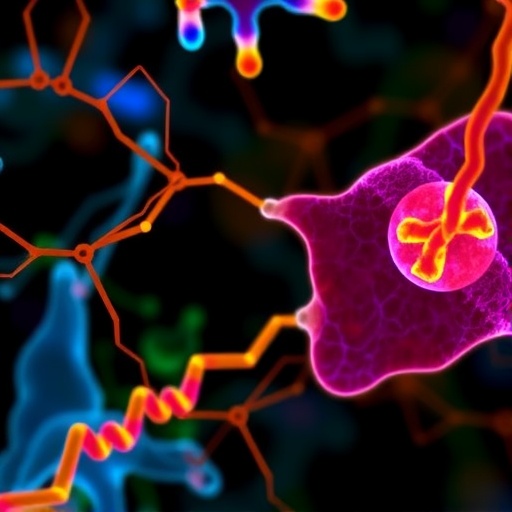In the relentless pursuit of effective cancer therapies, vaccines targeting tumor-associated carbohydrate antigens (TACAs) represent a promising frontier. These carbohydrate structures, overexpressed on the surface of malignant cells, have long been recognized as critical markers for tumor progression, cell adhesion, and metastatic potential. However, their inherently poor immunogenicity—largely due to their T-cell independent nature—has hampered efforts to develop robust cancer vaccines. Addressing this challenge, an innovative study led by Xin-Shan Ye and colleagues from Peking University introduces a groundbreaking strategy involving chemical modification at the glycosidic linkage of the sialyl-Tn (STn) antigen, a prominent TACA, thereby setting a new paradigm in cancer vaccine design.
Carbohydrate antigens like STn have traditionally been viewed as elusive targets because their native structures are susceptible to enzymatic degradation and tend to elicit weak immune responses dominated by B-cell activity without potent T-cell engagement. Previous vaccine candidates such as Theratope® attempted to exploit STn antigens but ultimately failed to produce enduring clinical benefits, primarily due to insufficient immunogenic potency and rapid metabolic degradation. The present study innovates by chemically altering the fundamental glycosidic bond within STn, substituting the naturally labile O-glycosidic linkage with a more stable synthetic N(OMe)-glycosidic bond, thereby enhancing the antigen’s metabolic resilience and immunogenicity.
The concept of modifying the glycosidic linkage itself departs radically from conventional approaches that focus on acyl group alterations or other peripheral chemical modifications of carbohydrate antigens. By specifically targeting the bond that connects the sugar moiety to serine or threonine residues in the peptide backbone, the researchers protected the vaccine antigen from enzymatic cleavage without compromising its three-dimensional conformation essential for immune recognition. This meticulous chemical engineering maintains antigen authenticity, enabling the immune system to mount a cross-reactive response with the native STn found on tumor cells.
Experimental evaluation revealed that the N(OMe)-STn conjugated to keyhole limpet hemocyanin (KLH), a highly immunogenic carrier protein, elicited robust and selective immune activation. Notably, this conjugate exhibited heightened resistance to enzymatic hydrolysis, thus persisting longer in vivo to drive sustained immune engagement. Immune profiling demonstrated an impressively balanced Th1/Th2 T-cell response, critical for orchestrating both cellular and humoral immunity. This balanced immune activation contrasts with previous carbohydrate vaccines that often failed to induce significant T-helper cell involvement, a prerequisite for durable and effective antitumor immunity.
In vivo studies further substantiated the vaccine’s potency, showcasing significant antitumor effects manifested by prolonged survival and notable reduction in metastatic lesions in murine cancer models expressing native STn antigens. The vaccine’s mechanism extends beyond antibody generation, as it induced functional antibodies capable of mediating complement-dependent cytotoxicity (CDC) and antibody-dependent cellular cytotoxicity (ADCC), two key effector functions that lead to tumor cell lysis and clearance. This dual mode of action highlights the comprehensive anti-cancer potential encompassing both direct tumor killing and facilitation of immune system engagement.
The implications of this research are profound, in part because STn expression is characteristic of several aggressive carcinomas, including breast, ovarian, and gastrointestinal cancers. The failure of past vaccine efforts illuminated the pressing need for antigen designs that overcome immune tolerance and elicit high-affinity, T-cell dependent antibody responses. By harnessing an unprecedented chemical modification strategy at the glycosidic linkage, this vaccine candidate transcends those limitations, offering a versatile platform that can be adapted for other TACA-based vaccines, potentially revolutionizing the field of carbohydrate antigen vaccine development.
Furthermore, the study exemplifies how chemical biology and immunology can intersect to solve longstanding obstacles in vaccine science. The meticulous synthetic chemistry required to create the N(OMe)-glycosidic bond, coupled with sophisticated immunological assays, underscores the multidisciplinary nature of this breakthrough. This approach not only protects the antigen from degradation but also fine-tunes its immunological presentation, ensuring that the immune system perceives the modified sugar as a genuine pathogenic marker while generating broadly cross-reactive antibodies.
One of the most compelling aspects of this vaccine design is its potential as a generalizable strategy—denoted as Modification of Carbohydrate Antigen Structures (MCAS)—that can be extended beyond STn. Such an approach could enable the development of vaccines targeting a variety of TACAs associated with different tumor types, addressing a critical bottleneck in the field where the immunogenic weakness of carbohydrate antigens has limited clinical translation. The ability to chemically engineer glycosidic linkages opens new avenues for the design of tailored vaccines that maintain antigen authenticity while enhancing immune recognition.
This research also provides valuable insights into the importance of glycosidic bond stability in antigen processing and presentation. Enzymatic cleavage of native O-glycosidic linkages has been an underappreciated hurdle in effective antigen persistence, and this work elegantly demonstrates that chemical stabilization at this site can profoundly affect vaccine efficacy. By preserving antigen integrity, the modified vaccine ensures longer exposure to immune cells, thereby facilitating improved antigen presentation via major histocompatibility complex (MHC) molecules and subsequent T-cell activation.
Additionally, the balanced induction of both Th1 and Th2 responses observed in vaccinated models is notable because it optimizes the orchestration of cell-mediated and antibody-mediated immunity. Th1 responses promote cytotoxic T lymphocyte activity critical for attacking tumor cells, while Th2 responses bolster antibody production, including IgG subtypes instrumental in CDC and ADCC. This equilibrium is crucial to achieving potent and sustained antitumor effects without inducing immune tolerance or dysfunction.
Beyond the scientific implications, the translational potential of the N(OMe)-STn–KLH conjugate vaccine is substantial. Given the demonstrated enhanced stability, immunogenicity, and functional antibody induction, this candidate is well-positioned for advancement into clinical development pipelines. The work also underscores the importance of integrating chemical design with immunological evaluation to overcome intrinsic biological barriers in vaccine technology.
In summary, the pioneering work by Ye and colleagues heralds a new era in carbohydrate antigen-based cancer vaccines by chemically reinforcing the glycosidic bonds vulnerable in natural antigens. This strategy not only surmounts prior hurdles associated with poor immunogenicity and rapid degradation but also establishes a blueprint adaptable to other challenging tumor markers. With robust preclinical efficacy and a mechanism supported by detailed biochemical and immunological rationale, this novel vaccine design invigorates hope for more effective immunotherapies against devastating STn-expressing cancers.
Subject of Research: Cells
Article Title: A cancer vaccine based on N-linked sialyl-Tn antigen elicits robust and selective antitumor immunity
Web References: http://dx.doi.org/10.1016/j.glycos.2025.100006
Image Credits: Xin-Shan Ye, et al
Keywords: Cancer, Immunology, Vaccine research, Medical cybernetics
Tags: chemically modified cancer vaccinesenhancing antitumor immune responseglycosidic bond modificationglycosylation in cancer treatmentinnovative cancer therapy strategiesmetabolic stability in vaccinesnovel vaccine design approachesovercoming vaccine limitationsPeking University cancer researchSTn antigen immunogenicityT-cell independent antigenstumor-associated carbohydrate antigens





